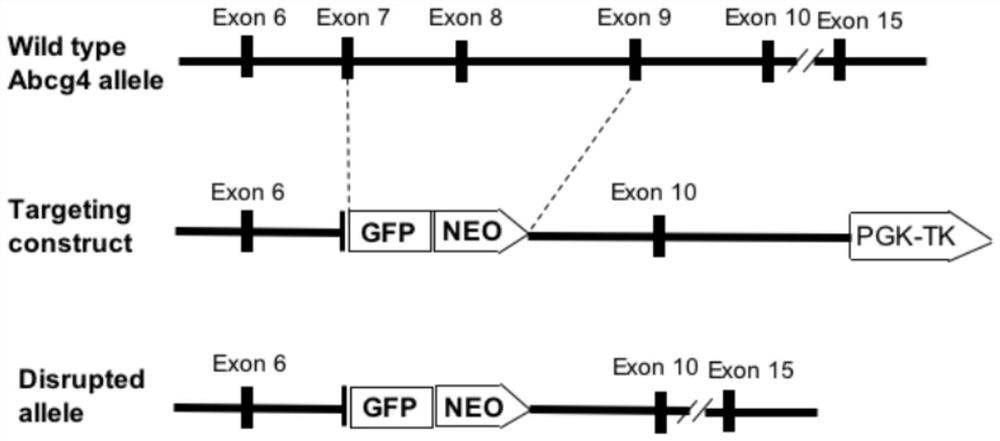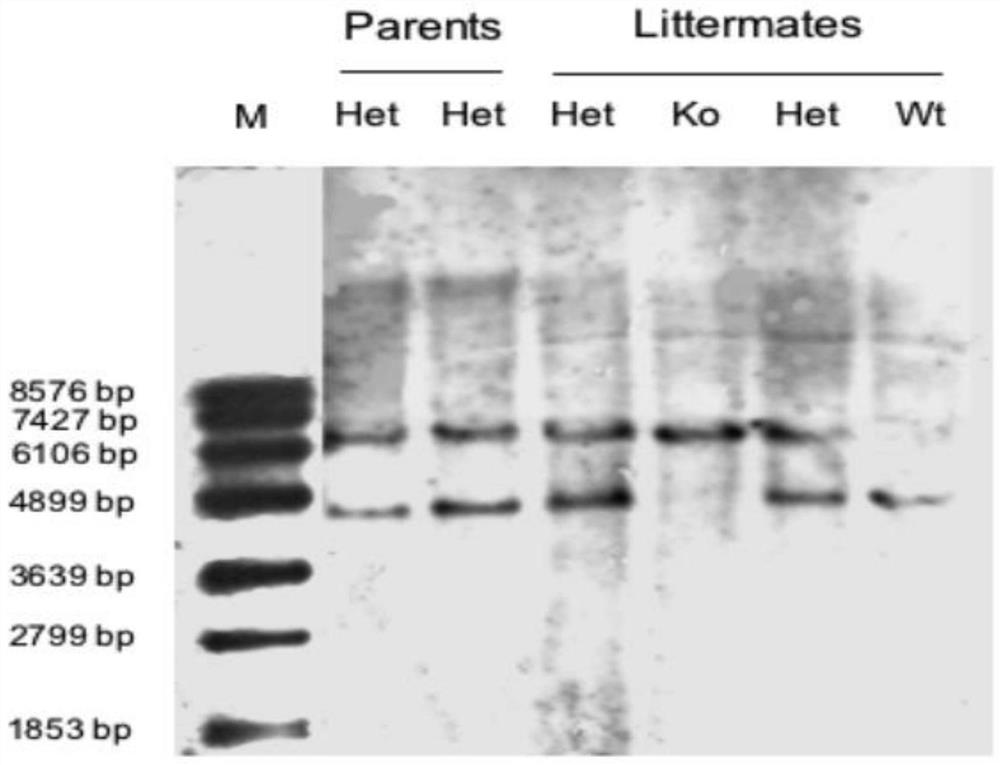Application of abcg4 gene in constructing animal model with two-way change in obesity degree
A technology of genes and uses, applied in the field of Abcg4 gene in the construction of animal models with bidirectional changes in the degree of obesity
- Summary
- Abstract
- Description
- Claims
- Application Information
AI Technical Summary
Problems solved by technology
Method used
Image
Examples
Embodiment 1
[0041] see figure 1 , the method for knocking out mouse Abcg4 gene of the present embodiment, comprises the steps:
[0042] Using the wild-type mouse genome as a template, the primer pair I was used to amplify the fragment comprising the 6th exon to part of the 7th exon of the Abcg4 gene, denoted as fragment I;
[0043] The nucleotide sequence of the primer pair I is:
[0044] FI:5'-TGGTGGATGGTGCAGATGAC-3' (as shown in SEQ ID NO.1);
[0045] RI: 5'-AAATCGGGGTGGTGCTTAGG-3' (as shown in SEQ ID NO.2);
[0046] Amplify the fragment comprising the 9th-14th exon of the Abcg4 gene with primer pair II, denoted as fragment II;
[0047] The nucleotide sequence of the primer pair II is:
[0048] FII:5'-AACTGACGAAGAAGCCGGAG-3' (as shown in SEQ ID NO.3);
[0049] RII: 5'-ATCAAAGAAGGACTGCCCCG-3' (as shown in SEQ ID NO.4);
[0050] Amplify the fragment comprising the 9th-14th exon of the Abcg4 gene with primer pair II, denoted as fragment II;
[0051] S2. Insert fragment I into the eG...
Embodiment 2
[0059] Genotype identification of Abcg4 gene-deficient mice
[0060] Confirm the correctness of homologous recombination with Southern hybridization, including the following steps:
[0061] The genomic DNA of the Abcg4 gene-deficient mouse obtained in Example 1 and the genomic DNA of the wild-type mouse were first digested with BgII enzyme, and probes were made for Southern hybridization detection.
[0062] The preparation method of the probe is as follows: PCR amplification of genome DNA is first performed with primers int2F-2 and int5R. The sequence information of int2F-2 and int5R is as follows:
[0063] int2F: 5'-CAGTACACAGGTTAAGCTAGGCAG-3' (as shown in SEQ ID NO.5)
[0064] int5R: 5'-TCCATACACAGGCCTCGCCTAAGC-3' (as shown in SEQ ID NO.6)
[0065] The PCR reaction system is: DNA template 10ng, primers 2ug, Taq enzyme 1unit, 1×PCR buffer, and the total reaction volume is 20ul.
[0066] PCR reaction conditions: 94°C, 5 minutes; cycle: 94°C, 30 seconds, 60°C, 45 seconds, 7...
Embodiment 3
[0069] Characterization of Abcg4 gene-deficient mice using indicators of obesity
[0070] The following results were compared with Abcg4 gene-deficient mice and wild-type mice born in the same littermate at 4 weeks after birth.
[0071] (1) Analysis of triglyceride content
[0072] Analysis process and results: using the triglyceride analysis kit from Boehringer Mannheim and operating according to its instructions, the results are as follows image 3 shown.
[0073] (2) Analysis of paragonadal fat pad
[0074] Analysis process and results: mice were anesthetized, weighed and recorded body weight, dissected mice, took out paragonadal fat pad, weighed and recorded, the results were as follows: Figure 4 shown. The ratio of the fat pad weight to the body weight of the mouse is the fat content rate (in percentage), and the results are as follows Figure 5 shown.
[0075] (3) Pancreas weight analysis
[0076] Analysis process and results: the mice were dissected to take out ...
PUM
 Login to View More
Login to View More Abstract
Description
Claims
Application Information
 Login to View More
Login to View More - R&D
- Intellectual Property
- Life Sciences
- Materials
- Tech Scout
- Unparalleled Data Quality
- Higher Quality Content
- 60% Fewer Hallucinations
Browse by: Latest US Patents, China's latest patents, Technical Efficacy Thesaurus, Application Domain, Technology Topic, Popular Technical Reports.
© 2025 PatSnap. All rights reserved.Legal|Privacy policy|Modern Slavery Act Transparency Statement|Sitemap|About US| Contact US: help@patsnap.com



